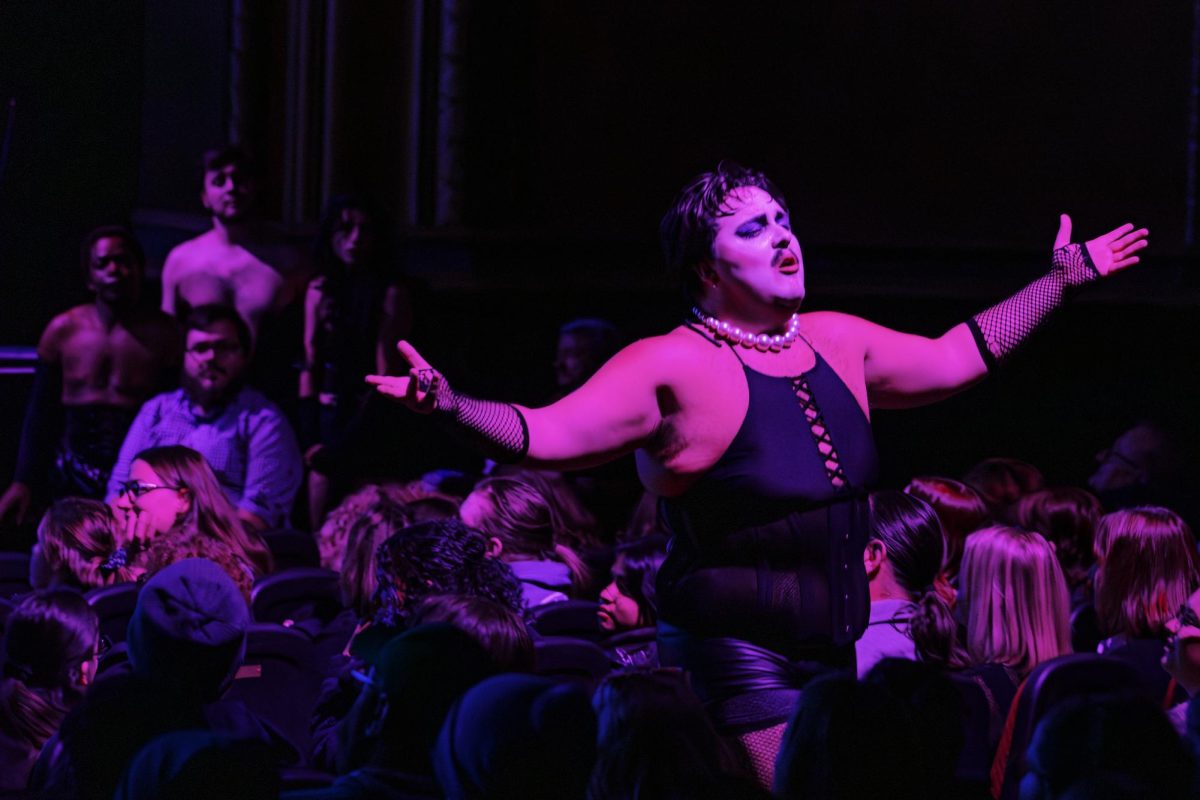October Dance 2023 took to Krannert Center for the Performing Arts’ Tryon Festival Theatre from Wednesday to Saturday with four nights of powerful performances presented by University dance students.
The annual event, hosted by Dance at Illinois, consisted of five pieces performed one night over livestream and three nights in-person. The two-hour show displayed a diverse array of dance styles and performers.
While each piece brought a uniqueness to the stage, Concert Director and Head of the Department of Dance Sara Hook wrote in a note to the audience that every piece shared a theme of community.
“The fellowship of community is something that all the social sciences identify as indicative of a healthy society,” Hook wrote.
A comfortably filled theater saw the curtain rise a little after 7:30 p.m. on Friday night.
Get The Daily Illini in your inbox!
October Dance’s first piece, “Summon. Sow. Reap, ” choreographed by Cynthia Oliver, saw five dancers take the stage with erratic movements to a series of rhythmic clicking.
The modern and eclectic dance style was interrupted by a more casual break in the middle of the piece, where the dancers swayed to the beat accompanied by claps and cheers from the audience.
Eventually, the dancers returned to small intricate moves to a series of clicks, representing what Hooks described in her program note as “a post postmodern abstraction of community.”
The small group took their bows to applause from the audience.
The next group then took the stage for the second piece of the night “Atay?,” choreographed by Nawal Assougdam.
Four women took the stage to a cozy setting of pillows and a tea set. Assougdam presented elements of Moroccan culture by constructing a scene of the dancers joyfully coming together for a tea ritual.
Assougdam noted to the audience that midway through rehearsing the piece, the country of Morocco was heavily impacted by an earthquake. The student choreographer dedicated the piece to the thousands of lives lost in the disaster, as well as her family.
The headlining work of October Dance, “Steps in the Street,” brought the historic work of choreographer Martha Graham to the Krannert Center. Graham, founder of the oldest school of dance in the U.S. and creator of the Graham technique, is regarded as one of the most influential figures in American dance.
Taught to University students by regisseurs Miki Orihara and Elizabeth Auclair, the short but powerful piece included 11 dancers. Beginning with slow and shuffling steps, the dance grew toward flowing on and off the stage in an energetic rhythm.
A small panel was held at the Spurlock Museum prior to opening night. Auclair, Hook and Illinois dance faculty member Betsy Brandt did a deep dive into the piece and the process of rehearsing it with Illinois students given the present political climate.
“Steps in the Street” was originally considered a lost piece, Auclair said, after its 1936 premiere in New York City. Graham helped to reconstruct the piece and have it performed once more in the early ʼ90s, when it earned an “overwhelming reaction,” Auclair said.
The dance represents the complex emotions associated with war, which was important to discuss with Illinois dance students in context with recent events in Israel, Brandt said.
“It felt like a really honest conversation,” Brandt said about speaking with her students. “It’s really complicated. Everything’s really complicated.”
Auclair added that “Steps in the Street” has “zeroed in on the human experience of war,” rather than emphasizing an importance in “picking sides.”
“This shows the devastation of spirit that happens to everyone,” Auclair said.
Additionally, the panelists discussed the theme of solidarity in the piece. Brandt said while “Steps in the Street” was originally created to be performed by only women, the Illinois performance chose to be gender inclusive.
Auclair added that the intention of the piece, with similar movements and choreography performed by each dancer, was to encourage community and solidarity rather than conformity.
Following “Steps in the Street,” a much more upbeat and peppy act took the stage with choreographer and Assistant Concert Director Alexandra Barbier’s “yESteRDaZe.”
Providing a sharp contrast to the night’s previous pieces, Barbier used choreography from music videos of the ʼ90s and early 2000s in a schoolroom setting. Audience members were brought on stage to sit in desks and join in learning some moves.
Barbier narrated throughout the dance as four dancers jumped rope, played hand-clap games and sang nursery rhymes. Barbier discussed growing up through dance, uniting with her friends to learn choreography at sleepovers and bringing “viral” moves to school dances.
“yESteRDaZe” earned appreciative whooping and clapping along from the crowd to hits such as Nelly’s “Country Grammar” and DJ Jubilee’s “Get Ready, Ready.” The audience laughed and clapped along as Barbier created a nursery rhyme about her experience growing up, and the dancers performed an energetic number to it.
October Dance 2023 closed out with “Bells for Us,” choreographed by Anna Sapozhnikov, performed by 13 first-year members of Dance at Illinois.
For this piece, the backdrop and side curtains were completely removed, revealing the raw lighting and backstage of Tryon Festival Theatre. The number involved both large and small group elements as selections of dancers took to the stage in turns.
The dancers moved smoothly and expressively to pulsing noise emanating from the speakers. Costumed in shining dress shirts, the performers blended together in a solid rush of movement as they propelled from one side of the stage to the other.
The first year members earned a lengthy round of applause from the audience. The crowd left the theater buzzing about the performances of the night.






